Nuts Design Notes
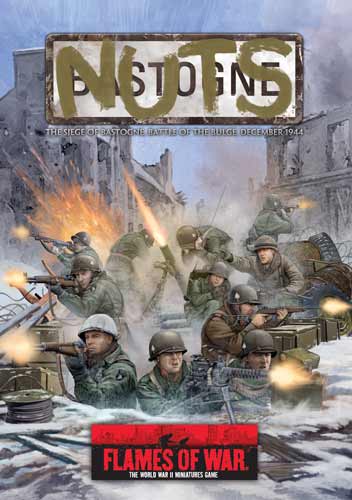 | Nuts Design Notes with Wayne Turner Our third and final book in our Lorraine and Ardennes themed series is Nuts, The Siege of Bastogne, Battle of the Bulge, December 1944. As the title suggests this book covers the fighting around Bastogne, the US 101st Airborne Division’s epic defence and the German attempts take the town. The name of the book comes from General McAuliffe, acting commander of the 101st Airborne Division, in his reply to the Germans’ ultimatum to surrender Bastogne on 22 December 1944, when he simply replied ‘Nuts!’ However, Nuts also covers Operation Nordwind, the German attack in Northern Alsace-Lorraine, just south of the Ardennes. The German launched this attack take advantage of the distraction caused by their Ardennes offensive. Both German operations saw the first heavy use of new Volksgrenadier Divisions, the new type of infantry division introduced by the Germans, designed to fully utilise their limited manpower by introducing increased firepower with new weapons like the StG44 assault rifle. Check out Nuts in the online store here... |
| Battlefront TV Visit the Battlefront TV channel on YouTube here... | |
| Nuts! Battle Report Setting Up The Battlefield Mike and Phil lay out a challenging table in preparation for the upcoming NUTS! Battle Report and discuss what makes for interesting terrain. | The Game With Nuts, the third in our Bulge series of books coming out we took the opportunity to lure Wayne and James back to the gaming table. Wayne's Volksgrenadier Company found itself attacking James' Parachute Rifle Company (based around Easy Company). |
 |
| US Forces The focus of the US Forces in Nuts is the 101st Airborne Division. They arrived in Bastogne by truck just a few short days after the Germans launched their Ardennes offensive, not yet fully recovered from their fighting in Holland. Under strength and short on weapons they soon had Bastogne cordoned off and stood ready to hold off the German attacks. They were joined in the defence by elements of the 9th and 10th Armored Divisions and the 705th Tank Destroyer Battalion. |
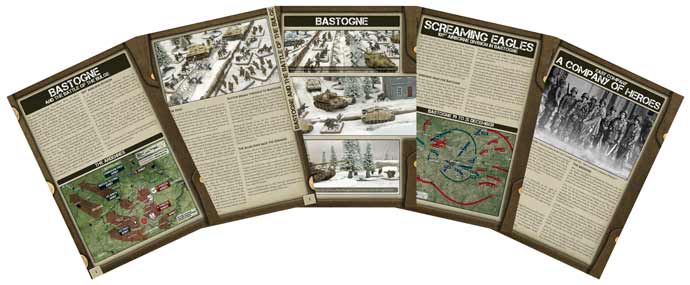 |
| In Nuts you can take a Parachute Rifle Company, Airborne Engineer Combat Company or a Glider Rifle Company. The Fearless Veteran Parachute Rifle Company are particularly tough fighters. When they first arrived in Bastogne the paratroopers grabbed extra weapons and ammunition from retreating riflemen to make up for their own shortages, often boosting the number Bazookas over what they were normally issued. They are supported by their own battalion assets such as machine-guns and mortars, but can also call on the firepower of the division and supporting armoured forces like tank destroyers, tanks, armoured infantry, glider artillery, parachute artillery and heavy artillery. |
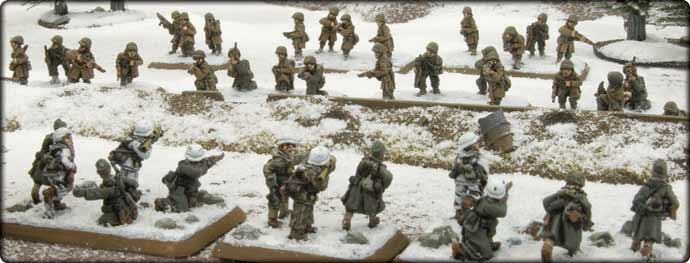 |
| The Glider Rifle Company are experienced fighters after Holland and defended one of the busiest sectors of the Bastogne perimeter during the siege, fending of countless attacks by German forces as they attempted to breach the line by circling around the west of Bastogne. As well as the glider battalions’ own weapons platoons of anti-tank, machine-guns and mortars the glidermen were also supported by the division guns and armoured forces. The glidermen were also not shy in supplementing their defence with extra weapons left behind by retreating US forces, with many platoons adding .50 cal machine-guns and extra bazookas to their arsenals. |
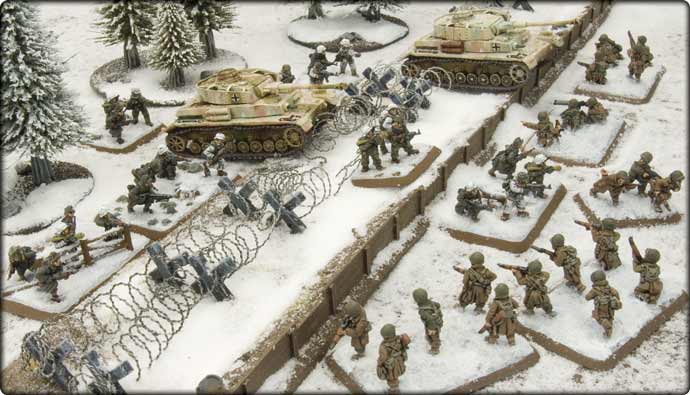 |
| As mentioned above all three types of companies were well supported, often due to circumstance rather than design. This was because a number of retreating units also arrived in Bastogne and came under the command of the 101st Airborne Division. Armoured support came from CCR, 9th Armored Division and CCB, 10th Armored Division, as well as the M18 Hellcat tank destroyers of the 705th Tank Destroyer Battalion attached the division. The armored division Combat Commands came with Sherman tanks, further M18 tank destroyers, armored infantry, armored artillery and anti-aircraft half-tracks. After the siege was broken the airborne troops were joined by the veteran 4th Armored Division around Bastogne. |
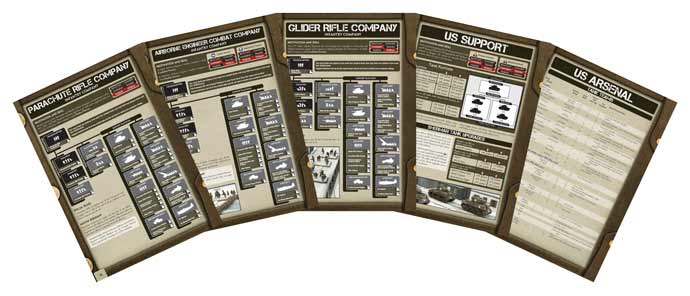 |
| Stragglers from the retreating infantry divisions were also rounded up and formed into adhoc Rifle Platoons. M1 155mm howitzer armed 755th and 969th Field Artillery Battalions were also caught in Bastogne and joined the defence. One of these battalions, the 969th, was manned by African-American soldiers and had also absorbed the remnants of another African-American artillery unit, the 333rd Battalion after it had be overrun during the initial German attacks. |
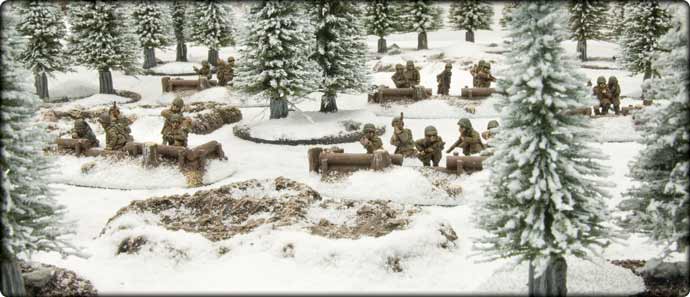 |
| US Warriors The US Warriors in Nuts feature the famous men of Easy Company, 2nd Battalion, 506th Parachute Infantry Regiment of the 101st Airborne Division. You can enhance your Parachute Rifle Company by adding Captain Richard Winters, Lieutenant Ronald Speirs, First Sergeant Carwood Lipton, Private Eugene Roe, Corporal Darrell ‘Shifty’ Power or the Toccoa Sergeants. Each has unique abilities and your can add them all, or just some, it’s up to you. |
 |
| For example, with the Toccoa Sergeants you represent the old hands leading the platoons of the company. For +10 points a Toccoa Sergeant replaces a platoon command team in a Combat or Weapons Platoon and gives you the Currahee! rule, which allows the platoon he commands to re-roll, failed Motivation Tests to rally form being Pinned Down. Or you could add First Sergeant Carwood Lipton who replaces your 2iC Command team for +25 points and allows you to re-rolled failed Platoon Morale Checks. Captain Richard Winters is a Higher Command team and can be added for +70 points. His two rules are Captain Nixon and A Band Of Brothers. The Captain Nixon rule allows Combat and Weapons Platoons to use the Eyes and Ears rule, while A Band Of Brothers allows Winters to re-roll the first failed Company Morale Check. |
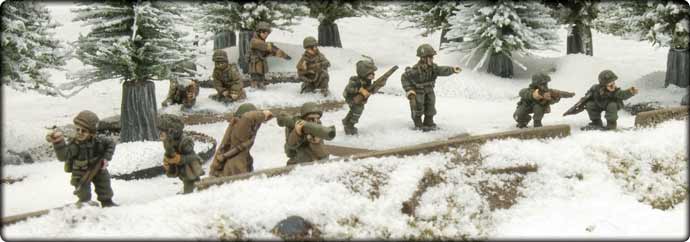 |
| German Forces Nuts contains three new German companies for Flames Of War. The first of these is a Volksgrenadierkompanie (People’s Grenadier Company). The Volksgrenadier divisions were a newly created type of infantry division that began forming in late 1944 and saw extensive fighting during the battles in Alsace-Lorraine, the Ardennes and Germany in 1944 and 1945. They were formed to replace the massive losses after the Soviets smashed Army Group Centre in the east. These new divisions were primarily focuses on defence, economising on manpower and increasing firepower. |
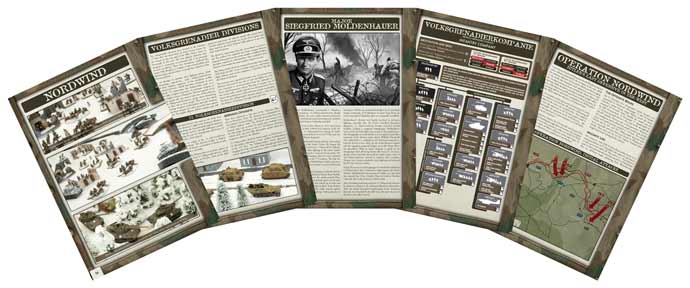 |
| Among their new weapons was the StG44 assault rifle. This weapon armed two of the three combat platoons, giving them a higher rate of fire than normal K98 rifles, but at a shorter range. Like submachine-guns, the assault rifles also allow the Volksgrenadiers to shoot on the move with no reduction of fire. These platoons are the Volksgrenadier Sturm Platoons, and as well as their Assault Rifle teams, they can also have a single squad of MG teams armed with MG-42 machine-guns for longer range support fire. The third combat platoon is the Volksgrenadier Schützen Platoon. This platoon is armed more in line with conventional grenadiers with K98 Rifles and MG-42 machine-guns, making them Rifle/MG teams. They provide supporting fire to the Sturm platoons. In additional the weapons mentioned, both types of platoon are also fully equipped with Panzerfaust anti-tank weapons, making them a formidable proposition to any attacking enemy tanks. |
 |
| A Volksgrenadierkompanie can also rely on the support of its weapons platoons with mortars, machine-guns and a choice of two new infantry guns. The new infantry guns are the 7.5cm IG37 and 7.5cm PaK50 guns. The IG37 fits an infantry gun to a light and mobile PaK36 trail and is simple a modernisation of the old IG18 gun. The PaK50 is a more innovative design. The gun is a cut down Pak40. Its short length is combined with a light PaK38 anti-tank gun trail to make it easy to handle. Being based on the PaK40 is retains good anti-tank capabilities (AT10), while still being able to deliver high-explosive punch demanded from an infantry gun (Range 24”/60cm, ROF2, FP3+) and it can fire bombardments. |
 |
| Regimental and divisional support includes heavy mortars, scouts, tank-hunters, anti-tank, pioneers, anti-aircraft, artillery and rocket artillery. During the opening of the Ardennes offensive the Volksgrenadiers infiltrated through the US lines before their attacks were launched in full. The Volksgrenadier Scout Platoon uses the Stosstaktik special rule, with which your Volksgrenadierkompanie Always Attacks against other infantry companies. It also gives your combat platoons and your Volks Pioneer Platoon Spearhead Deployment (see page 261 of the rulebook). |
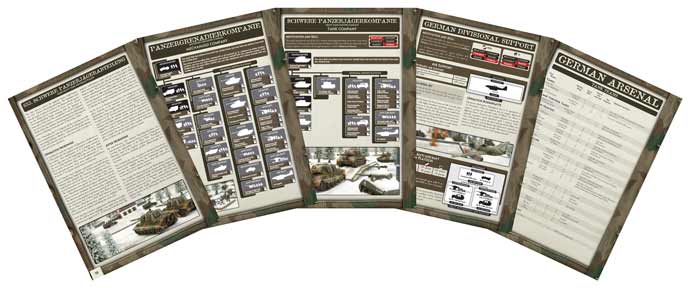 |
| The Volksgrenadiers didn’t operate alone and can call on support from SS and Heer panzer forces. So further support can come from Panzer, Panzergrenadier, Jagdtiger, Sturmtiger, and Skorzany Commando platoons. The second German company available in Nuts is the Panzergrenadierkompanie (motorised grenadier company). This company is based on 17. SS Panzergrenadierdivision and 25. Panzergrenadierdivision. These two divisions were the two lead divisions of Operation Nordwind. Panzergrenadier divisions normally only have the one panzer battalion and usually do not have armoured half-track mounted infantry. However, for Nordwind both divisions were reinforced. 17. SS Panzergrenadierdivision received the support of the Jagdtiger heavy tank-hunters of the 653. Schwere Panzerjägerabteilung, while 25. Panzergrenadierdivision had recently absorbed the 107. Panzerbrigade, inheriting an extra panzer battalion of Panther tanks and a battalion of armoured infantry. 25. Panzergrenadierdivision also worked closely with 21. Panzerdivision, which was down to about a brigade in strength at the time of Nordwind. This all gives these two divisions a lot heavier support than you would normally expect for a motorised Panzergrenadier force. |
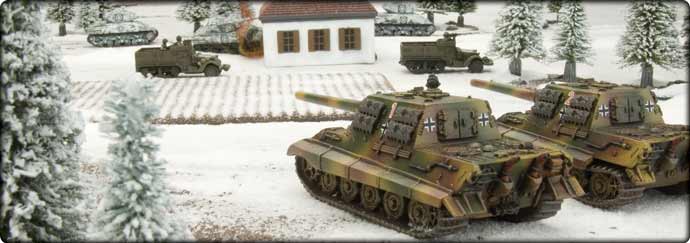 |
| Another new weapon introduced during Nordwind was the Flammpanzer 38(t) Hetzer. These flame-throwing assault guns were organised into two companies and issued to each of the Panzergrenadier divisions. They supported 25. Panzergrenadierdivision while it fought its way through the Maginot Line. The flame-throwers are particularly effective suppressing bunkers where the pioneers and infantry could then knock them out. |
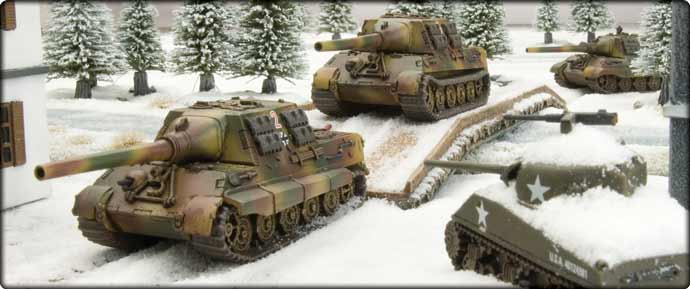 |
| Out final German company in Nuts is the Schwere Panzerjägerkompanie. This company represents the newest development in heavy tank-hunter technology, the Jagdtiger. This massive 75 tonne beast is armed with a 12.8cm gun (Range 48”/120cm, ROF2, AT17, FP2+) and has to 120mm of armour on it front (Front 16). The Jagdtiger was issued to 653. Schwere Panzerjägerabteilung who initially were to be deployed to take part in the Ardennes offensive, but mechanical issues meant they could not make it to their start positions in time. Instead it was decided that their first test in combat would be during Operation Nordwind. During Nordwind they supported 17. SS Panzergrenadierdivision and later 10. SS Panzerdivision during the attacks on the Maginot Line. |
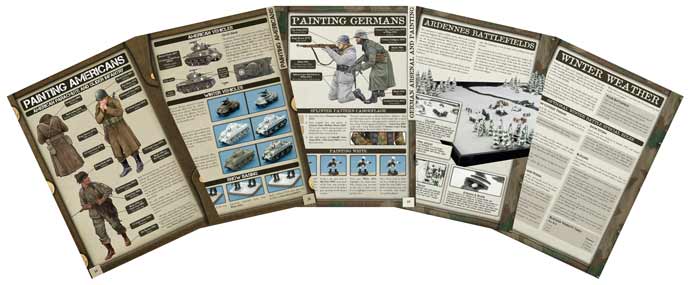 |
| A number of support platoon also warrant a mention. The Sturmtiger heavy assault howitzer returns to take part in the Battle of the Bulge. These ultimate bunker busters were planned to be used for the closing stages of the operation and the assault on the Belgian city of Liege. We’ve take the opportunity to review the rules, making them more in line with the Sturmtiger’s battlefield role as an urban assault vehicle. Two other option for those familiar with Devil’s Charge make a return to Nuts. The Skorzany Command Groups also worked with the Volksgrenadiers during the opening stages of the Ardennes offensive, so they and their box of dirty tricks have been included as support options. We have also included the Luftwaffe air support of Operation Bodenplatte with Me 262 A2a Sturmvogel jet fighter-bombers. These high-speed jets can’t be intercepted! We have also added an additional aircraft option, the FW 190F, which is armed with cannons and bombs for ground attack. |
 |
| German Warrior Nuts also contains a Warrior for use with the Volksgrenadierkompanie. Major Siegfried Moldenhauer was the commander of a Battalion of the 48. Volksgrenadier Regiment, 12. Volksgrenadierdivision during the Ardennes offensive. He was massively experienced officer who had spent over 70 days in close combat during his carrier on the eastern front. His Close Combat Clasp in Gold rule keeps his men motivated in the face of enemy fire, allowing them to unpin if stopped by defensive fire. He also had an Infantry Assault Badge and his experience of hand to hand combat means he hits on 2+ in Assaults. As a battalion commander he is a Higher Command team, giving him extraordinary powers of command on the battlefield. |
 |
| Use with the Blood, Guts, and Glory and Devil’s Charge Nuts can be used in conjunction with Blood, Guts, and Glory and Devil’s Charge to recreate the wide variety of battles seen through campaigns of late 1944 and early 1945 throughout Alsace-Lorraine, the Ardennes and on the German border. The US infantry forces from Devil’s Charge and US armored forces from Blood, Guts, and Glory are also designed to represent the forces facing the Germans during Nordwind. Volksgrenadier divisions also faced US infantry forces from Devil’s Charge as well as fighting during the Lorraine campaign against US armored forces. I hope you all enjoy playing with the forces from Nuts as much as I enjoyed creating them |

Ingen kommentarer:
Legg inn en kommentar